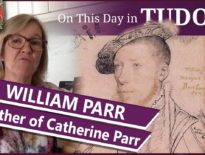On this day in Tudor history, 13th August 1579, Roman Catholics Friar Conn, or Connatius, O'Rourke and Patrick O'Healy, Bishop of Mayo, were hanged just outside Kilmallock, co. Limerick.
So desperate was Sir William Drury, Lord President of Munster, to get rid of these two Catholics, that he used martial law to find them guilty of treason, rather than giving them a trial. Find out why, what Drury did to poor Bishop O'Healey, and what happened to their remains afterwards, in today's talk.
Also on this day in history, 13th August 1514, Princess Mary Tudor, youngest surviving daughter of the late King Henry VII and sister of King Henry VIII, married King Louis XII of France by proxy. Find out more about the ceremony, what everyone was wearing, and about the symbolic consummation, in last year’s video:
Also on this day in history:
- 1566 – Death of Sir Humphrey Radcliffe, member of Parliament, at his manor of Elstow. He was buried in Elstow Church. Radcliffe served as a member of Parliament during the reigns of Mary I and Elizabeth I, and then as a JP and Sheriff in Elizabeth I's reign.
- 1568 – Death of William Barlow, Bishop of Chichester. He was buried in Chichester Cathedral.
Transcript:
On this day in Tudor history, 13th August 1579, Roman Catholics Friar Conn, or Connatius, O'Rourke and Patrick O'Healy, Bishop of Mayo, were hanged just outside Kilmallock, co. Limerick.
O’Rourke and O’Healy were from the County Leitrim area and had joined the Franciscan Order before travelling to the Continent to train as priests. O’Healey, who was born in around 1545, had studied theology and philosophy in Spain, and had also trained as a priest there. In 1575, he travelled to Rome on behalf of Sir James Fitzmaurice who was planning a military expedition to Ireland to defend the Catholic faith there. In 1576, while he was in Rome, Pope Gregory XIII made O’Healey Bishop of Mayo.
In the winter of 1577/8, O’Healey and Fitzmaurice set sail from Portugal for Ireland, but had to abandon the journey due to storms. Fitzmaurice decided to travel to Spain and O’Healey went to Paris, where he helped to educate young priests of the Franciscan Order and took part in public disputations at the Sorbonne, impressing everyone with his knowledge and command of theology and philosophy. It was in Paris that he met Conn O’Rourke, who had been born in around 1550. In the summer of 1579, O’Healey and O’Rourke, dressed as sailors, took a boat from Brittany to Ireland, landing at Smerwick Harbour in County Kerry. The two of them travelled through Kerry and Limerick to Askeaton, home of Gerald Fitzgerald, 14th Earl of Desmond, cousin of Fitzmaurice and a powerful man. They hoped that he would help them, seeing as he had no love for Elizabeth I and had even been imprisoned in the Tower of London for a time. The earl was absent and the countess feared that his involvement in rebellion would lead to his execution and the loss of his lands and property in Ireland, but she kept this to herself and offered hospitality to the bishop and priest.
After spending three days with the countess, O’Healey and O’Rourke set off, planning to travel on through Limerick to Mayo, the bishop’s diocese. However, while they were on the road, the countess, who was keen to prove her loyalty to Queen Elizabeth, sent word to the Mayor of Limerick of these travellers. The mayor’s men apprehended O’Healey and O’Rourke and they were imprisoned in Limerick jail.
While the two of them were imprisoned, on 18th July 1579, Fitzmaurice landed at Smerwick with several hundred soldiers and called on the Irish people to join him in rebellion. While the English set about sending soldiers to put down his rebellion, Sir William Drury, Lord President of Munster, travelled to Limerick to question O’Healey. Drury questioned the bishop about Fitzmaurice, the Pope and King of Spain, and their plans for invasion, believing that O’Healey and O’Rourke had been sent ahead by Fitzmaurice and had information. O’Healey refused to talk even when nails were hammered into his fingers, his hands and feet were broken, and then his fingers were torn from his hands. Drury then used martial law to condemn the two men for treason without a trial, ordering for them to be hanged.
O’Rourke and O’Healey were then bound with rope and taken to Kilmallock. As the men were taken to the trees that would act as their gallows, they recited the litany and gave each other absolution. After encouraging O’Rourke to be strong in the face of death, Bishop O’Healey addressed the crowd, calling on them to be steadfast in their faith and in their obedience to the pope. He then asked for their prayers. The two men were then hanged to death and their bodies left there for about a week, being used as target practice by soldiers, before being laid to rest.
Less than two months later, on 3rd October, Sir William Drury died, something that the people of Ireland saw as retribution for his treatment of these two faithful men.
The two men were beatified by Pope John Paul II in September 1992.



Leave a Reply